Getting Started: Hiking for Beginners (Hiking 101)
Hiking is essentially a long and vigorous walk over varying terrains. Walks are shorter in duration than hikes and can be taken anywhere.
Hiking is usually done out in nature. It’s also a low-intensity workout. Many people use hiking to lose weight and get in shape.

There may be affiliate links in this post. If you make a purchase, I earn a small commission at no extra cost to you. Thank you.
There are many different kinds of hikes, and no two hikes are exactly alike. There are day hikes, overnight hikes, thru-hikes, urban hikes and more.
Depending on where you go, you may experience vastly different terrains. Some trails are completely paved. Others are entirely made of dirt or grass.
You may encounter still others that are a combo of roots, rocks and dirt. It all depends on the hiking trail and region.
In this article, you’ll find everything you need to know to get started hiking as a beginner.
Hike Alone or With Friends
Which hiking option is best for you? Hiking alone, hiking with a partner or joining a group hike at a park or trail.
Me, I do all three. Sometimes I hike alone, sometimes with a good friend and sometimes I join a hike I find listed by a Meetup group.
Hiking Alone

It’s typically suggested that beginner hikers use the buddy system. But, sometimes that’s just not possible.
Whether you enjoy the peace of a solo hike or schedules simply don’t match up and you have no choice but to hit the trail alone, here are some tips.
First, choose a popular trail. A well-trafficked trail might sound like the opposite of what you want to do if you value solitude, but it’s a wise choice.
There will still be opportunities for silence and solitude, and popular trails are a safer option. Trafficked trails are often well-maintained and well-marked.
If you need help, there will likely be other hikers in the area to assist you.
Second, always tell someone where you are going. Let a spouse, friend or family member know where you are going and when you plan to return.
In the AllTrails app, it’s easy to share your intended hike via email or text. If you’re new to hiking and choose to hike alone, take all safety precautions.
Before you leave, check the weather. Head out early enough to enjoy plenty of daylight. You don’t want to hike after dark (not without a headlamp).
Choose a shorter trail and don’t wear headphones. Make sure you’re familiar with local wildlife and poisonous plants to properly handle undue encounters.
Hiking With a Friend or Group
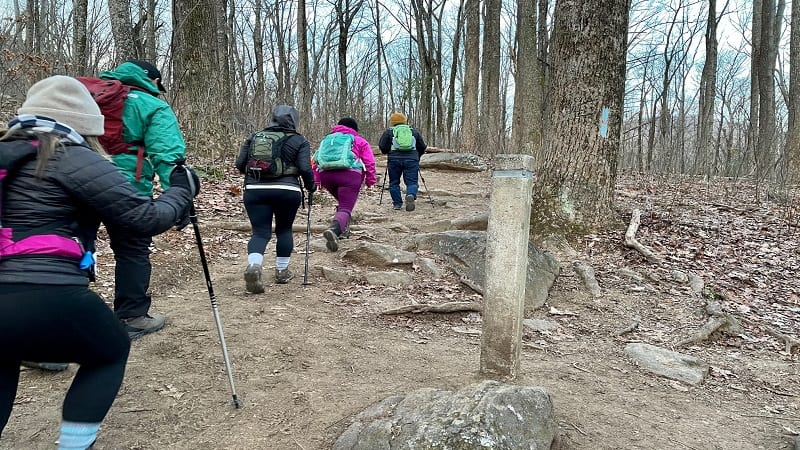
For new hikers, hiking with a partner or group is the best option. There’s safety in numbers. It’s also a great way to make new friends with similar interests!
If you don’t have a friend or family member to invite on your hike, the internet is a great way to find new hiking buddies.
There are many hiking groups on Facebook, for example. Girls Who Hike VA has more than 19,000 members in a private group.
It’s not unusual to see new members share their location (a city or region), availability and interest in finding a friend for a hike.
Don’t be afraid to put yourself out there, but do be careful when sharing private details, like your phone number or social media accounts.
How to Find Hiking Buddies

Many local areas have Meetup groups dedicated to hiking. These groups arrange area hikes for groups. Individual can sign up for what they like.
You’ll find hikes for all levels, from beginners to advanced hikers. You can search for hiking groups in your area at www.meetup.com.
Facebook groups are another great way to connect with local hikers! Search for groups to connect with local hikers and attend hiking outings.
Here are a few hiking Facebook and Meetup groups in Virginia:
- Scrambled Legs & Kegs Hiking Group (Facebook)
- GetHiking! Charlottesville (Meetup)
- Hike Like A Girl #HikeLAG (Meetup)
Always take safety precautions when meeting new people online. Let someone know who you’re meeting, where you’ll be and when you plan to be back.
If it’s one person, research them online ahead of time. Vet their online profiles for legitimacy if possible. Most importantly, always trust your instincts.
When you’re hiking with someone new for the first time, hike in familiar areas. If possible, opt for trails with great cell signal throughout the entire hike.
How to Choose a Hiking Route
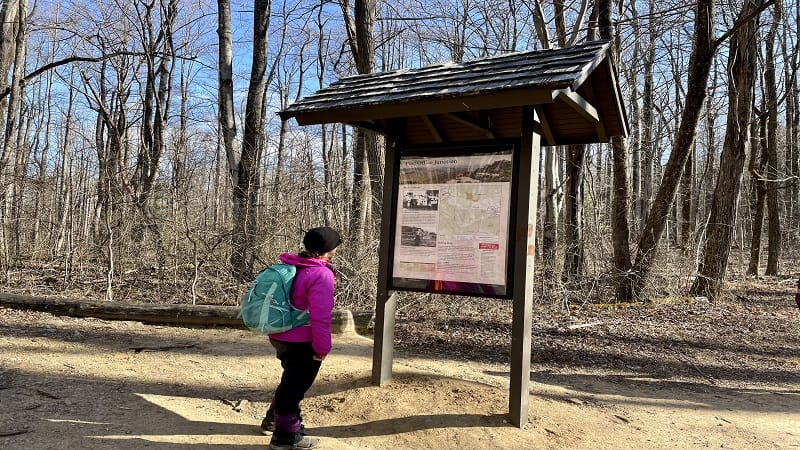
As a beginner hiker, it’s important to know how to choose the right hiking route for you. You don’t just want to set off on any hiking trail.
Choosing the right trail is about so much more than the views you’ll see along the way. Here are some important things to consider.
Fitness Level
Before considering any other factor, get real about your fitness level. Choosing a trail that is too difficult or too long for your physical abilities is a bad idea.
Many new hikers overestimate their abilities. This can sometimes lead to unsafe situations and tragic consequences.
The number one cause for hiker search and rescue operations in 2014 was fatigue and physical fitness levels.
Of those rescues, the majority of them were day hikers, according to this study by the National Park Service.
Don’t overestimate your ability to tackle a “difficult” trail as a new hiker. When in doubt, choose one that you think will be a breeze. You might be surprised!
Hike Length
The average person hikes at a speed of about two miles per hour. If you make many stops or there’s a lot of elevation gain, you will hike more slowly.
Be sure that you choose a trail that’s short enough to give you plenty of time to return before dark. Also, plan for stops and delays, even on an easy trail.
Factor your physical fitness level into choosing a trail length. Remember that hiking can be more strenuous than simply walking around your neighborhood.
Elevation Gain
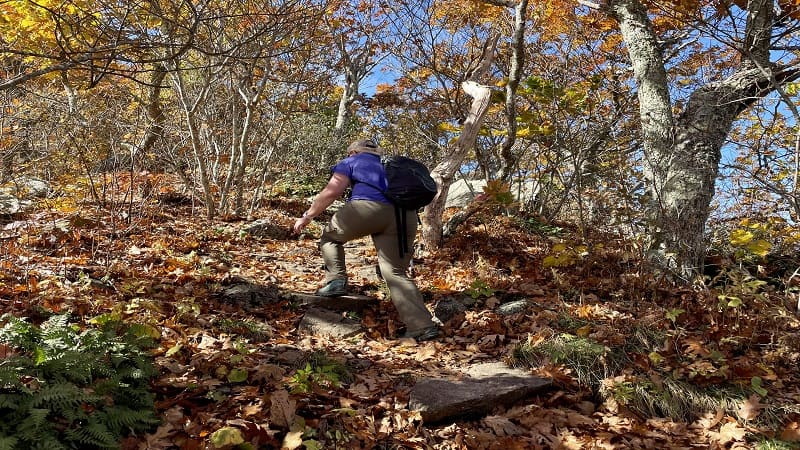
When researching hiking trails, databases like AllTrails will share the elevation change to expect on an individual hike.
A number on a screen doesn’t seem like such a big deal, but hiking uphill, especially for extended periods of time, can be rather exhausting.
Weather
Always check the weather forecast before leaving for a hike. Even if you’ve checked it the day before, check it again right before heading out the door.
Weather conditions can change in a moment. It’s best to be prepared. Going up in elevation, like into the mountains, can be much colder, so bring extra layers.
Daylight and Darkness
One mistake many new hikers make is setting out too late in the day and finding themselves hiking in the dark. Always note the day’s sunset time.
Hiking in the dark is fine if you’re prepared for it and know how to read the trail. But if you’re not, it can be terrifying.
Always leave early enough in the day to have plenty of light for your entire hike. If you think you may cut it close, bring along a fully-charged headlamp.
Seasonal Considerations
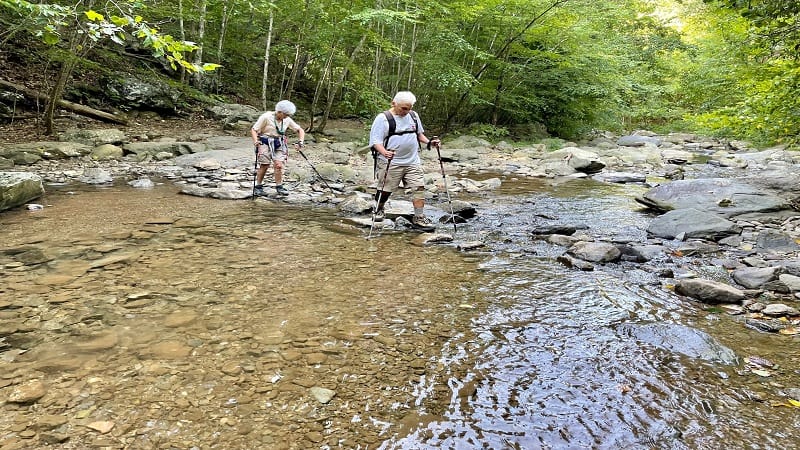
If it’s a winter hike, will the trail be covered in snow and hard to find? In the spring, will it be too muddy or will there be swift-moving water crossings?
Consider the season, recent weather, like an overnight rain, and trail conditions when selecting a hike.
Mobile apps and websites like AllTrails can have reviews from recent hikers. This is a good place to start when considering current trail conditions.
Parking
Lastly, consider parking. Parking is often an afterthought, but some lots fill up fast! Meanwhile, some roads require a 4×4 vehicle to access the trailhead.
Be sure you’re familiar with the roads leading to the trailhead and what parking is like. You may need to arrive early to get a space in a parking lot.
Where to Find the Best Hiking Route

There are many places you can look to find the best hiking trail for you.
Of course, you can look for hiking trails in Virginia on this site. Every hike lists length, time to complete, elevation gain, terrain and level of difficulty.
AllTrails is another great resource for finding hiking trails. This free service allows you to search hiking trails near you by length and difficulty level.
You can also ask family and friends for suggestions, or consult with a hiking guide. You can bring guides with you on the trail – no cell service required.
I wrote two hiking guidebooks that were published in 2022 if you’d like to check them out. Both titles are below.
Hiking with Kids Virginia: 52 Great Hikes for Families
Hiking Coastal Trails of Delaware, Maryland and Virginia
If you opt for a hike you find on AllTrails, remember to download the route to your phone to help you follow the trail.
Training and Preparing for a Hike
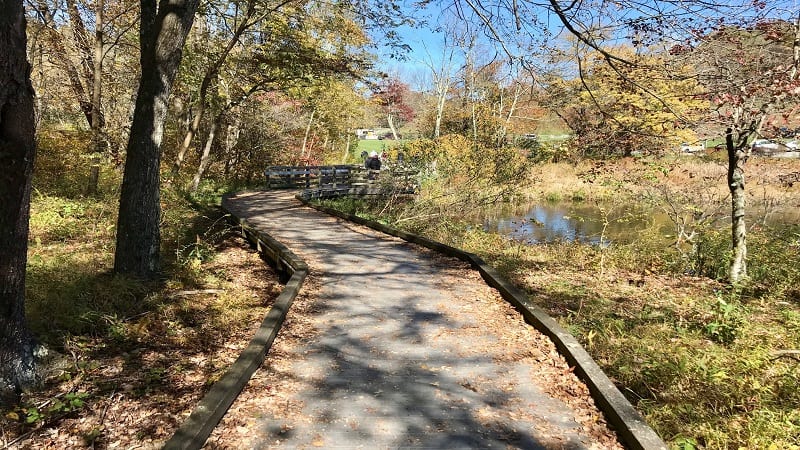
The amount of training you need to do for a hike is entirely dependent on the type of hike and difficulty of the trail that you choose.
For easy hikes, the most you may need to do is get a good stretch session in before you hit the trail.
However, if you’re planning for a long hike, backpacking trip or strenuous trail, you’ll need to train ahead of time.
Cardio exercises and strength training will help improve your stamina and keep you hike-ready for the length and elevation gain of most any trail.
The point of training for hiking is to increase your endurance levels, build strength in your legs and core, and improve your balance for uneven terrain.
If you have a long hike coming up, it’s a good idea to start your training schedule at least eight weeks in advance.
Essential Hiking Gear
Every hiker should carry the right gear on every hike, no matter the length. The Cub Scouts recommend six essentials, but there are a few more.
- First Aid Kit: bring along a basic first aid kit with bandages, alcohol pads, gauze and antibiotic ointment.
- Water Bottle: always have a way to carry water with you!
- Flashlight: bring a flashlight or headlamp for emergencies. No, your cell phone flashlight is not “good enough.”
- Trail Food: bring along lightweight and nutrient-dense snacks, and bring more than you think you’ll need.
- Sun Protection: sunscreen and hats will help protect your skin from harmful UV rays, even in winter.
- Whistle: always pack a whistle for emergency use.
- Shelter: a lightweight tarp can be used as a shelter in a pinch and easily packs in the bottom of your bag.
- Knife: bring along a knife — you never know when you’ll need it!
- Navigation: whether you use paper maps, a compass, or have an off-grid GPS system, bring one along.
- Extra Clothing: bring extra clothing in a dry bag. Layers will help keep you dry and warm in changing temperatures and conditions.
More Hiking Basics to Bring on the Trail
Now that you know the essential items to bring along on every hike, even the most simple day hike, here are a few more basics.
- Day Pack: A quality day pack is perfect for carrying all your essential items. Some daypacks come with a waterproof cover, or you can bring a trash bag for this purpose.
- Solar Charger: a solar charger is a great way to keep your essential electronics charged up while on the trail.
- Water Filtration: it’s not always possible to carry all the water you need. A water filtration device will make any water source safe.
- Fanny Pack: some hiking fanny packs have a spot for your water bottle and a pocket big enough for snacks, your cell phone, and a headlamp.
What to Wear on a Hike
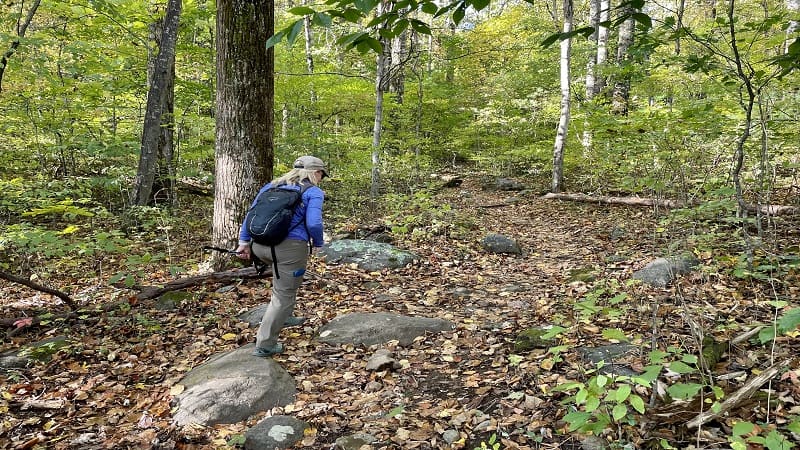
Some materials are better than others when it comes to performance in the outdoors. When possible, avoid cotton and denim.
These materials absorb and hold water and moisture from sweat and humidity. They can lead to hypothermia in chilly temperatures.
The best wearable materials for hiking are lightweight, breathable materials that won’t absorb sweat and moisture. Polyester helps keep you cool and dry.
Merino wool is another great option. Keeping warm and dry on winter hikes is all about layering breathable materials like polyester, Merino wool and fleece.
Bring a hiking jacket if you have one that can pack away easily! Meanwhile, keep the jeans at home. Jeans are not a good idea even for a short hike.
Your hiking boots should be season-appropriate and fit well. A good pair of hiking boots not slip on your feet or heels as this can cause blisters.
If possible, break in your hiking boots before your first hike. Shoes that aren’t broken in or cause blisters make for a miserable hiking experience.
Running shoes or tennis shoes are an acceptable option for a short hike on flat terrain. If your hike is in a rugged area, hiking boots are your best choice.
Lastly, a sun hat is a good idea to keep the sun off of your face and neck. Sunglasses are fine, but they don’t protect your skin like a sun hat does.
Hiking Etiquette
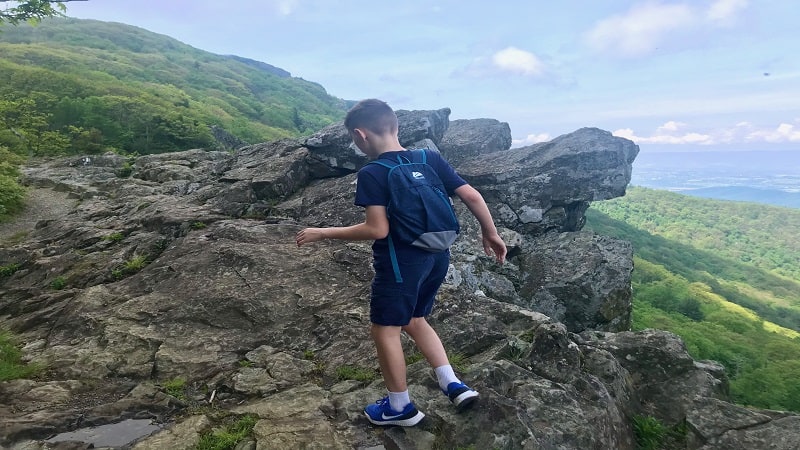
There are certain hiking rules you should always follow on any trail. Here are the most important things to remember.
- Right of Way: Hikers, Bikers and Horses
- Downhill hikers should always yield to uphill hikers
- Bikers should always yield to hikers and horses
- Hikers should always yield to horses and other pack stock. Also, remain quiet and still as they pass so you don’t spook them.
- Noise on Trail: avoid playing music on hiking trails or being loud. Other hikers come out enjoy nature, not to hear the latest hits or podcasts.
- Leave No Trace: Leave no trace means leaving no trash, food waste, leaving things alone and not altering the natural environment.
- Do not litter! Even if your packaging says biodegradable.” Take it to a dedicated garbage can.
- Don’t leave any food waste behind. Food waste like banana peels, apple cores, even jelly drips can attract wildlife.
- Don’t take things with you. Leave rocks and sticks on the trail where you found them!
- Stay on trail and don’t alter nature. That means no rock stacks, no fire rings, no tree or rock carvings.
- Kids and Dogs: With kids, teach them general hiking etiquette like keeping the noise down, staying on trail, and leaving no trace.
- Remind children to leave plants alone and never feed wildlife.
- When hiking with dogs, always follow trail rules regarding our canine friends.
- Keep your dog on a leash and always clean up pet waste and properly dispose of it in a trash can off the trail.
How to Stay Safe While Hiking
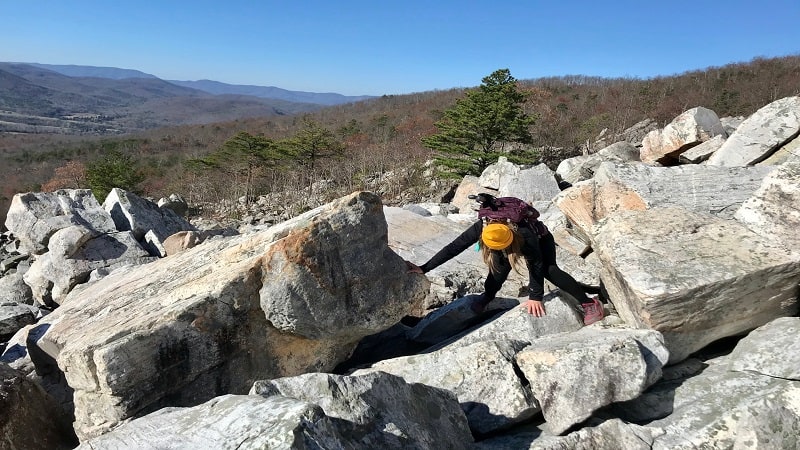
Planning and preparation are essential to staying safe while hiking. These tips are not meant to scare you, but to help prepare you for a safe hike.
Accidents can happen in an instant, but taking precautions ahead of time ensures the best possible outcome. Here are the best ways to stay safe on a hike.
Tell Someone
Always let someone know where you’re going. Give them the trail name, your departure time and estimated return time.
I send my husband a link to the trail I’m hiking using AllTrails. I also use Life360, a family location-sharing app, so he can see my location in real-time.
Write an Itinerary
Write out an itinerary of your hike and leave it inside your car. Include your time of departure from the trailhead and the trails you expect to hike that day.
If something happens to you and you can’t get off the trail, an itinerary left in your car will help searchers find you as fast as possible.
Carry a Map and Compass
These days, everyone relies heavily on smartphone navigation apps. However, it’s a good idea to learn how to read a paper map and use a compass.
Topographical maps can help you identify certain points on a trail or in an area. A compass will point you in the right direction if you get lost.
Respect Wildlife
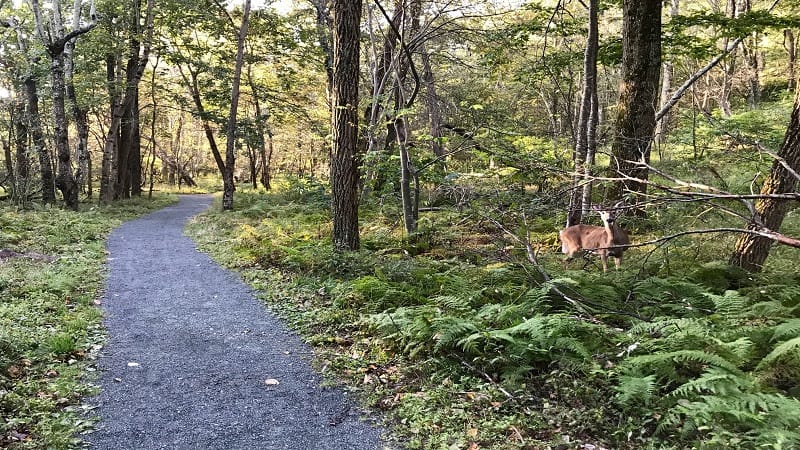
If you respect wildlife and leave them alone, they’ll do the same for you.
In areas with black bears, be sure to make just enough noise to alert them to your presence. This gives them plenty of time to get out of the area.
A startled bear can be an angry bear. You can shout “Hey bear” periodically or use a bear bell to alert a bear to your presence.
If you come across wild animals, give them plenty of space and don’t make sudden movements. Allow them to clear the area at their own pace.
Familiarize yourself with the signs of aggression and research what to do if you encounter an angry member of the local wildlife population.
Stay On the Trail
It’s so important to stay on the trail. Too many stories involving lost hikers begin with “I just stepped a couple feet off the trail for a second.”
In wilderness areas, it can be incredibly easy to lose the trail and get lost, even if you just step off for a moment.
If you venture off the trail and get lost or injured, it will be much harder for searchers to find you in the rugged wilderness.
Carry a GPS System
If you plan to hike often or if you plan to hike in areas without cell phone signal, carrying a GPS satellite locator is always a good idea.
These devices, like the Garmin InReach, can be expensive. So they’re not a great investment if you’re trying to learn whether or not you like hiking.
However, if you plan to become an avid hiker, a GPS device can save a life!
Frequently Asked Questions

You’ve got questions, we’ve got answers! Here are the answers to the most frequently asked questions we get from beginner hikers.
What Should a Beginner Bring Hiking?
A beginner hiker should always bring along the six Cub Scouts hiking essentials that we mentioned above. Items include:
- First Aid Kit
- Water Bottle
- Trail Food
- Sun Protection
- Flashlight
- Whistle
Additionally, you should bring along a compass and map, water filter, solar charger, shelter and extra clothing.
Most items should fit fine in a day pack, which is a backpack made for hiking. You can also wear a fanny pack to keep your water, snacks and phone handy.
When packing for your first hiking trip, be mindful of how much extra weight you’re bringing. You should always have your essentials.
Note that a backpack that’s too heavy may hurt your back or cause muscle strain. This can also cause you to tire out early in the hike.
How Many Miles Should a Beginner Hike Be?
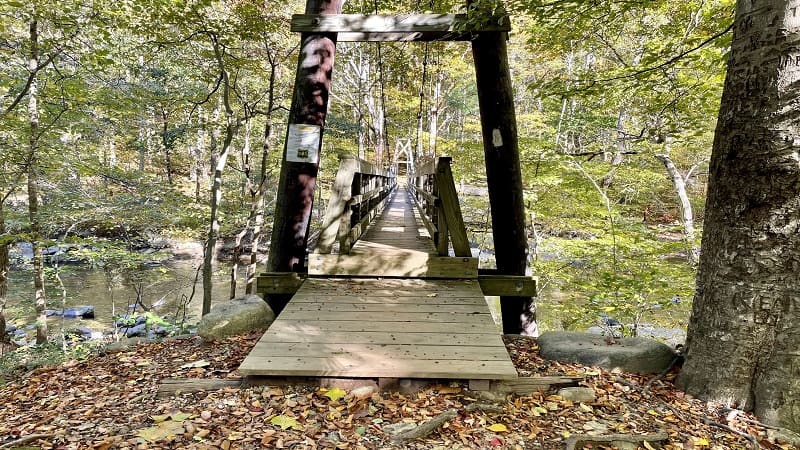
Since everyone’s personal fitness levels and endurance levels are different, there is no one-size-fits-all answer for this question.
An easy beginner hike length can range from one to five miles, depending on terrain and feet of elevation gain.
Hikes are typically rated as easy,” “moderate,” and “strenuous.” With these designations, it’s easy to choose hikes that fit your skill level.
When selecting a hike, also look at the type of trail. Out-and-back, for example, means you hike out to a point, then turn around and hike back.
Loop hikes (also called circuit hikes) are one-way hikes that make a loop where you end up at the same spot where you started.
How Do You Prepare for a Hike?
Preparing for a hike involves planning, research and making sure you have the proper gear.
First, be sure your chosen hiking trail is a good fit for the season and your abilities. Next, check the weather. Check it again before you leave.
Plan to leave early in the day and give yourself plenty of time to explore and make it back before dark.
Pack enough food, water and all your hiking essentials. Let someone know where you’ll be and what time you plan to return.
The night before your hike, go over all your essential items, check your route once more and check the weather.
Plan a healthy breakfast and get to bed early so you have plenty of rest to begin the hike.
Food for your hike should include nutritionally dense food that doesn’t require refrigeration and is easy to carry.
Bananas are a great source of potassium and can help prevent muscle cramps, making them a great pre-hike snack.
Before your hike, help your body prepare by eating a combination of complex carbohydrates and lean protein.
Examples include peanut butter and banana sandwiches, oatmeal with fruit, raisins and nuts, and more.
What Should You Not Do While Hiking?
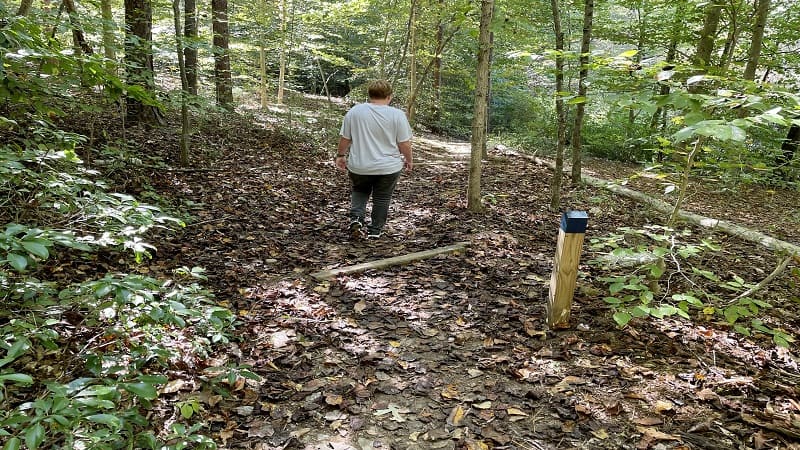
You should never choose a difficult trail as a beginner! You should also never leave litter, alter the natural landscape or feed wildlife.
Of course, never leave the trail. Don’t wear cotton or denim on your hike, and don’t wear shoes or hiking boots that fit improperly.
Finally, don’t skimp on preparation or hiking gear. It might seem unnecessary to bring so many hiking essentials, but it’s very important.
How Do You Carry Water While Hiking?
Typically, you carry water in a water bottle or hydration backpack while hiking.
You can put your water bottle in the mesh side pocket of your daypack, in the main pocket or hold it in your hand.
Hiking fanny packs are a great way to carry water while hiking and keep your hands free.
Many hip-belt hiking bags have a compartment for personal items and a water bottle holder on the side.
Walking with a water bottle in hand can get old fast, so it’s a smart idea to have an easily accessible place to store your water bottle.
How Much Water Should I Drink While Hiking?

The general recommendation for water intake is around half a liter of water per hour of moderate activity in moderate temperatures.
If it’s warmer or your hike is strenuous, you need to drink more water to stay properly hydrated. The same is also true for longer hikes.
If you can’t carry enough water and know there are water sources on your hike, bring a lightweight water filter to make any water source drinkable.
How Do You Get to Be Good at Hiking?
Becoming good at hiking is something you can only learn through experience, and you probably won’t become an experienced hiker overnight.
As you start out hiking easy trails, you’ll learn what you like and don’t like. The more you hike and learn to read trails and maps, the better you’ll get!
You’ll also learn more about yourself and your body, and have a better idea of what kind of trails and obstacles you can handle.
Cardio and strength training can help you increase your endurance and stamina and give you the strength to tackle hikes with a lot of elevation gain.
Although you can learn hiking basics through reading articles, the only way to become good at hiking is through practice and experience. Get on the trails!
Get Out There and Get Hiking

Getting started hiking as a beginner might feel daunting at first, but it’s not as overwhelming as it seems.
Don’t worry about having the latest hiking gear at first! Just make sure you have the essentials to stay safe on the trail and build from there.
The point of hiking is to have fun, be active and experience nature. These planning and safety tips will ensure you have the best experience possible!
If you don’t want to hit the trails alone, join local Meetup and Facebook groups to connect with hikers in your local area.
In addition to having hiking buddies, you’ll also learn valuable hiking tips from experienced hikers.
Plan appropriately. If you choose a trail that’s too hard, it could turn you off to hiking altogether.
Start small with a short and easy beginner hike and work your way up from there! There’s nothing like real-world hiking experience. Get out there!

Erin Gifford has completed more than 300 hikes in Virginia. She is also the author of three hiking guidebooks from Falcon Guides. Need help finding a hike? Check out the Trail Finder feature or send Erin an email at [email protected].




